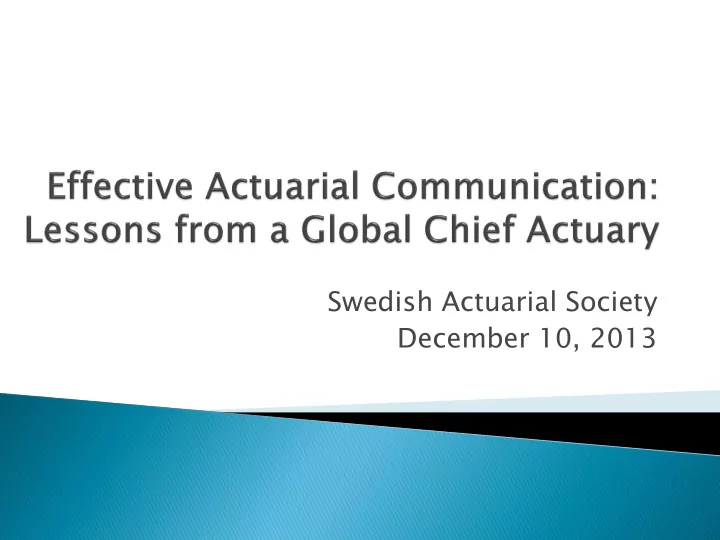

Swedish Actuarial Society December 10, 2013
Two Common Barriers Fear Inflexible Communication Style Two Common Situations Discussing Uncertainty Delivering “Bad” News
PUBLIC SPEAKING!!
The amygdala controls our response to change Active amygdala protects us in new situations Knowing how the amygdala works can help us understand ourselves and others
Be prepared in your message Allow time to develop a clear communication plan Write it out if it helps Breathe slowly and deeply Practice delivery/answering tough questions Seek formal training/opportunities to speak
Most people know the next three numbers: o 1, 2, 3, 4, 5….. Some people know the next three numbers: o 1, 3, 5, 7, 11…… A few people know the next three numbers: o 1, 8, 27, 64….
We add letters for numbers o 𝑌 + 3 = 106 We have imaginary numbers −1 = 𝑗 o Sometimes we don’t even use letters or numbers o ∞, ≥, ∑, Δ , π….
1. Reserved (0) Outgoing (10) 2. Not Easily Bored (0) Easily Bored (10) 3. Pessimistic (0) Optimistic (10) 4. Thin-skinned (0) Thick-skinned (10) 5. Diplomatic (0) Blunt (10) 6. Low Excitement Need(0) High (10) 7. Slow Paced (0) Fast Paced (10) 8. Low Social Contact Need (0) High (10) 9. Planner (0) Spontaneous (10) 10. Introvert (0) Extrovert (10) Source: Dr. Brian Little, Cambridge University
Dimension of Extroversion ◦ Score of 60 or higher Extrovert ◦ Score of 54 or less Introvert ◦ Score of 55 to 59 Ambivert
o Carl Jung introduced concept of introvert vs extrovert o Jerome Kagan studied “reactivity” in a group of four month olds through their adulthood o The amygdala plays a critical role in how we perceive our world and react to it (nature) o We live in an extrovert dominant world, so experience is also an important component (nurture)
Prefer to work independently, solitude can be a catalyst to innovation Aroused more by sensory stimuli in all senses Better at making a plan and staying with it Better at delaying gratification Tend to downplay rewards and scan for problems Can become overloaded with information Like people in friendly contexts (extroverts prefer competitors) Being an introvert does not mean: shy, afraid of people, more task-oriented, more intelligent.
US Americans live in a “Extrovert Ideal” value system centered around the individual. ◦ Value boldness and verbal skill, traits that promote individuality. ◦ Only 50% of Americans are true extroverts; the others are just pretending. Asian cultures are team-oriented, but not in the way that Westerners think of teams. ◦ Individuals in Asia see themselves as part of a greater whole – and place value on harmony within the group. ◦ Asians prize quiet, humility, and sensitivity, which foster group cohesion
You cannot change others, only yourself. “Prepare a face to meet the faces that you meet.” But stay true to yourself. ◦ We can stretch our personalities, but only up to a point. ◦ A professional is genuine.
Be prepared. Know your main points/subject matter and speak with conviction. A friendly smile when speaking and straight posture, even on a teleconference, makes one seem confident. Decisiveness inspires confidence, while wavering can threaten morale. Ensure you have a “restorative niche” in your daily life.
Directness: “American speakers come to the main point quickly” “The US is known for the use of the executive summary…’just give me the bottom line’” Informality: “ The use of first names is common. Individuals from a more formal culture are surprised by the ease with which ◦ people use first names with superiors” “Another part of this informality is a tendency to feel comfortable discussing private issues with a variety of ◦ individuals” Avoid Ambiguity : “ Many people in the US see issues in black and white ” ◦ Practicality/logic: “ Action- oriented Americans prefer the practical and specific and lack patience with the abstract and general” ◦ Use of Emotions and Humor: “It is common to show a some anger or pleasure…In addition, Americans use humor often. It is common to begin a ◦ speech with a joke.” Visual: “Americans generally enjoy presentations with charts, graphs, and other visuals.” ◦ The above is per an INSEAD executive education program.
Be prepared. Ask for opinions of those who are quiet. ◦ Don’t assume that everyone agrees or understands. ◦ Challenge the assumption that the person who speaks most eloquently is the most intelligent. Encourage individual work, reduce team meetings. ◦ Studies have shown that performance gets worse as group size increases. When making group decisions, listen to the introverts.
People look to us for “the” answer about something that is going to happen in the future. Problem: We know that whatever point estimate we give has a low chance of actually happening. There is really a range of estimates.
Be prepared. Understand what information is the most critical for your audience. Start with giving them your best point estimate (ROUNDED) based on the information you have and your analysis. Discuss potential volatility, both good and bad, in business terms. Use examples. Avoid statistical and financial jargon unless your dealing with statistical and financial people. Provide appendix of details if people want more information.
• Discuss plan • Keep audience and 2-3 informed of possible progress outcomes • Unpleasant including “what news is better if” action steps delivered early Before than late During Analysis Analysis Future After Monitoring Analysis • What needs to • Stay objective be monitored • Remember action going forward plan
Recommend
More recommend